Items filtered by date: February 2025
Clubfoot Occurs When Feet Take a Different Path
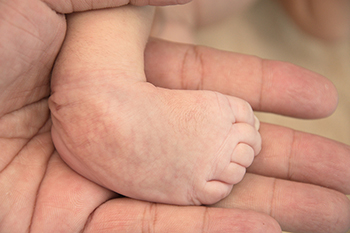
Clubfoot is a condition where a baby’s foot twists inward at birth, making it difficult to place flat on the ground. Although the cause is not fully understood, it develops in the womb as tendons and muscles pull the foot into an unusual position. Walking can be challenging without treatment, but early care can guide the foot into proper alignment. Rather than being a limitation, clubfoot is a challenge that modern medicine can overcome. With stretching, casting, and sometimes minor surgery, most children grow up with strong, functional feet. The Ponseti method, a gentle, step-by-step process, is highly effective in reshaping the foot. While clubfoot may look concerning at first, it does not define a person’s mobility for life. Children can run, jump, and play with the right care. If your child is born with clubfoot, it is suggested that you see a podiatrist as quickly as possible for expert guidance.
Congenital foot problems require immediate attention to avoid future complications. If you have any concerns, contact one of our podiatrists of Foot Care Centers of Palm Beach. Our doctors can provide the care you need to keep you pain-free and on your feet.
Congenital foot problems are deformities affecting the feet, toes, and/or ankles that children are born with. Some of these conditions have a genetic cause while others just happen. Some specific foot ailments that children may be born with include clubfeet, polydactyly/macrodactyly, and cleft foot. There are several other foot anomalies that can occur congenitally. What all of these conditions have in common is that a child may experience difficulty walking or performing everyday activities, as well as trouble finding footwear that fits their foot deformity. Some of these conditions are more serious than others. Consulting with a podiatrist as early as possible will help in properly diagnosing a child’s foot condition while getting the necessary treatment underway.
What are Causes of Congenital Foot Problem?
A congenital foot problem is one that happens to a child at birth. These conditions can be caused by a genetic predisposition, developmental or positional abnormalities during gestation, or with no known cause.
What are Symptoms of Congenital Foot Problems?
Symptoms vary by the congenital condition. Symptoms may consist of the following:
- Clubfoot, where tendons are shortened, bones are shaped differently, and the Achilles tendon is tight, causing the foot to point in and down. It is also possible for the soles of the feet to face each other.
- Polydactyly, which usually consists of a nubbin or small lump of tissue without a bone, a toe that is partially formed but has no joints, or an extra toe.
- Vertical talus, where the talus bone forms in the wrong position causing other bones in the foot to line up improperly, the front of the foot to point up, and the bottom of the foot to stiffen, with no arch, and to curve out.
- Tarsal coalition, when there is an abnormal connection of two or more bones in the foot leading to severe, rigid flatfoot.
- Cleft foot, where there are missing toes, a V-shaped cleft, and other anatomical differences.
- Macrodactyly, when the toes are abnormally large due to overgrowth of the underlying bone or soft tissue.
Treatment and Prevention
While there is nothing one can do to prevent congenital foot problems, raising awareness and receiving neonatal screenings are important. Early detection by taking your child to a podiatrist leads to the best outcome possible.
If you have any questions please feel free to contact our office located in Boynton Beach, FL . We offer the newest diagnostic tools and technology to treat your foot and ankle needs.
Treatment Options for Diabetic Foot Ulcers
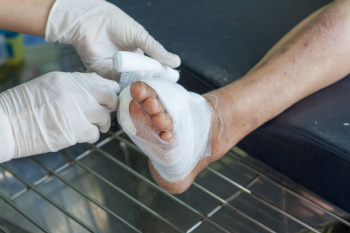
Diabetic foot ulcers develop when prolonged high blood sugar levels impair circulation and nerve function, increasing the risk of slow-healing wounds. Proper wound care for diabetic foot ulcers is essential to prevent complications, including infection. A podiatrist can assess the severity of the ulcer and recommend appropriate treatment, which may include debridement to remove dead tissue and specialized dressings that support healing. Offloading techniques, such as custom orthotics or specialized footwear, can help to reduce pressure on the affected area. In some cases, advanced treatments like negative pressure therapy may be used to promote tissue regeneration. Antibiotics may be prescribed if there are signs of infection. If conservative measures do not lead to improvement, surgery might be necessary to remove damaged tissue or correct structural deformities that contribute to ulcer formation. Regular monitoring by a podiatrist is essential to reduce the risk of more serious complications. If you have developed foot ulcers as a complication of diabetes, it is suggested that you schedule regular appointments with a podiatrist for ongoing treatment.
Diabetic foot care is important in preventing foot ailments such as ulcers. If you are suffering from diabetes or have any other concerns about your feet, contact one of our podiatrists from Foot Care Centers of Palm Beach. Our doctors can provide the care you need to keep you pain-free and on your feet.
Diabetic Foot Care
Diabetes affects millions of people every year. The condition can damage blood vessels in many parts of the body, especially the feet. Because of this, taking care of your feet is essential if you have diabetes, and having a podiatrist help monitor your foot health is highly recommended.
The Importance of Caring for Your Feet
- Routinely inspect your feet for bruises or sores.
- Wear socks that fit your feet comfortably.
- Wear comfortable shoes that provide adequate support.
Patients with diabetes should have their doctor monitor their blood levels, as blood sugar levels play such a huge role in diabetic care. Monitoring these levels on a regular basis is highly advised.
It is always best to inform your healthcare professional of any concerns you may have regarding your feet, especially for diabetic patients. Early treatment and routine foot examinations are keys to maintaining proper health, especially because severe complications can arise if proper treatment is not applied.
If you have any questions please feel free to contact our office located in Boynton Beach, FL . We offer the newest diagnostic and treatment technologies for all your foot and ankle needs.
Treat Your Feet to Diabetic Shoes
Foot Orthotics and Treating Common Foot Conditions
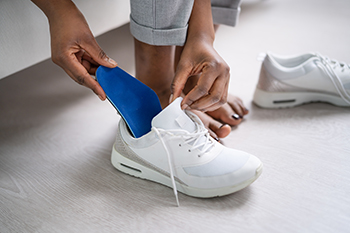
Foot orthotics are custom-made shoe inserts designed to provide support, improve alignment, and alleviate pain in the feet and lower limbs. They work by redistributing pressure across the foot and correcting abnormal motion. Foot orthotics can be particularly beneficial in treating conditions like Sever’s disease, sesamoiditis, tarsal coalition, and Achilles tendonitis. Sever’s disease, often affecting young athletes, can be treated with orthotics that relieve pressure on the heel and reduce strain on the growth plate. In the case of sesamoiditis, orthotics help by cushioning the forefoot and reducing stress on the sesamoid bones. Lastly, tarsal coalition, a condition where two or more bones in the foot fuse, can benefit from orthotics that correct foot mechanics and improve mobility. If you have foot pain, it is suggested that you consult a podiatrist who can determine the best course of treatment, which may include prescribing custom orthotics.
If you are experiencing discomfort in your feet and would like to try custom orthotics, contact one of our podiatrists from Foot Care Centers of Palm Beach. Our doctors can provide the care you need to keep you pain-free and on your feet.
What Are Custom Orthotics?
Custom orthotics are inserts you can place into your shoes to help with a variety of foot problems such as flat feet or foot pain. Orthotics provide relief and comfort for minor foot and heel pain.
Over-the-Counter Inserts
Shoe inserts come in a wide variety and are used to treat foot pain, heel pain, and minor problems. For example, arch supports can be inserted into your shoes to help correct overarched or flat feet, while gel insoles are often used because they provide comfort and relief from foot and heel pain by alleviating pressure.
Prescription Orthotics
If over-the-counter inserts don’t work for you or if you have a more severe foot concern, it is possible to have your podiatrist prescribe custom orthotics. These high-quality, custom inserts are designed to treat problems such as abnormal motion, plantar fasciitis, and severe forms of heel pain. They can even be used to help patients suffering from diabetes by treating foot ulcers and painful calluses and are usually molded to your feet individually, which allows them to provide full support and comfort.
If you're experiencing minor to severe foot or heel pain, it’s recommended to speak with your podiatrist about the possibility of using custom orthotics or shoe inserts. A podiatrist can determine which type of custom orthotic or shoe insert is right for you and help you take the first steps toward being pain-free.
If you have any questions please contact our office located in Boynton Beach, FL . We offer the newest diagnostic and treatment technologies for all your foot and ankle needs.
Causes and Symptoms of Acute Ankle Sprains
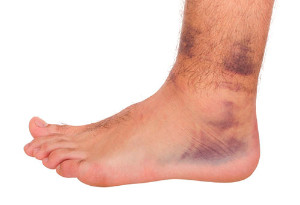
An acute ankle sprain occurs when the ligaments around the ankle are stretched or torn due to sudden twisting or impact. This injury typically happens during activities that involve jumping, running, or uneven surfaces, causing the ankle to roll or twist beyond its normal range of motion. The ligaments on the outside of the ankle are most often affected, although other ligaments can be injured as well. An acute sprain can occur in any age group, but it is especially common among athletes or individuals who engage in high-intensity physical activities. Risk factors include weak ankle muscles, improper footwear, or a previous ankle injury, which can make the ankle joint more vulnerable. The severity of the sprain can vary, with symptoms ranging from mild pain and swelling to more severe pain, bruising, and limited mobility. If you have injured or sprained your ankle, it is suggested that you promptly schedule an appointment with a podiatrist who can offer you appropriate treatment solutions.
Ankle sprains are common but need immediate attention. If you need your feet checked, contact one of our podiatrists from Foot Care Centers of Palm Beach. Our doctors can provide the care you need to keep you pain-free and on your feet.
How Does an Ankle Sprain Occur?
Ankle sprains take place when the ligaments in your ankle are torn or stretched beyond their limits. There are multiple ways that the ankle can become injured, including twisting or rolling over onto your ankle, putting undue stress on it, or causing trauma to the ankle itself.
What Are the Symptoms?
- Mild to moderate bruising
- Limited mobility
- Swelling
- Discoloration of the skin (depending on severity)
Preventing a Sprain
- Wearing appropriate shoes for the occasion
- Stretching before exercises and sports
- Knowing your limits
Treatment of a Sprain
Treatment of a sprain depends on the severity. Many times, people are told to rest and remain off their feet completely, while others are given an air cast. If the sprain is very severe, surgery may be required.
If you have suffered an ankle sprain previously, you may want to consider additional support such as a brace and regular exercises to strengthen the ankle.
If you have any questions please feel free to contact our office located in Boynton Beach, FL . We offer the newest diagnostic and treatment technologies for all your foot and ankle needs.
Managing an Ingrown Toenail
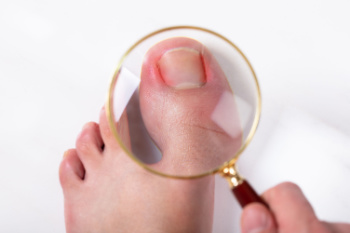
An ingrown toenail occurs when the edge of a toenail grows into the surrounding skin, causing pain, swelling, and redness. This condition commonly affects the big toe and can be caused by improper nail trimming, wearing tight shoes, or injury. People with naturally curved nails or certain foot conditions are more prone to developing ingrown toenails. Symptoms include sharp pain, swelling, redness, and in some cases, the formation of pus if an infection develops. The area surrounding the nail may feel tender or sore, especially when walking or wearing shoes. Treatment for an ingrown toenail starts with soaking the foot in warm water to reduce swelling. For mild cases, a podiatrist may lift the nail or trim it carefully. In more severe cases, part of the nail may need to be removed or treated with a local anesthetic. If you are experiencing an ingrown toenail, it is suggested that you schedule an appointment with a podiatrist for proper care.
Ingrown toenails can become painful if they are not treated properly. For more information about ingrown toenails, contact one of our podiatrists of Foot Care Centers of Palm Beach. Our doctors can provide the care you need to keep you pain-free and on your feet.
Ingrown Toenails
Ingrown toenails occur when a toenail grows sideways into the bed of the nail, causing pain, swelling, and possibly infection.
Causes
- Bacterial infections
- Improper nail cutting such as cutting it too short or not straight across
- Trauma to the toe, such as stubbing, which causes the nail to grow back irregularly
- Ill-fitting shoes that bunch the toes too close together
- Genetic predisposition
Prevention
Because ingrown toenails are not something found outside of shoe-wearing cultures, going barefoot as often as possible will decrease the likeliness of developing ingrown toenails. Wearing proper fitting shoes and using proper cutting techniques will also help decrease your risk of developing ingrown toenails.
Treatment
Ingrown toenails are a very treatable foot condition. In minor cases, soaking the affected area in salt or antibacterial soaps will not only help with the ingrown nail itself, but also help prevent any infections from occurring. In more severe cases, surgery is an option. In either case, speaking to your podiatrist about this condition will help you get a better understanding of specific treatment options that are right for you.
If you have any questions please feel free to contact our office located in Boynton Beach, FL . We offer the newest diagnostic and treatment technologies for all your foot and ankle needs.

